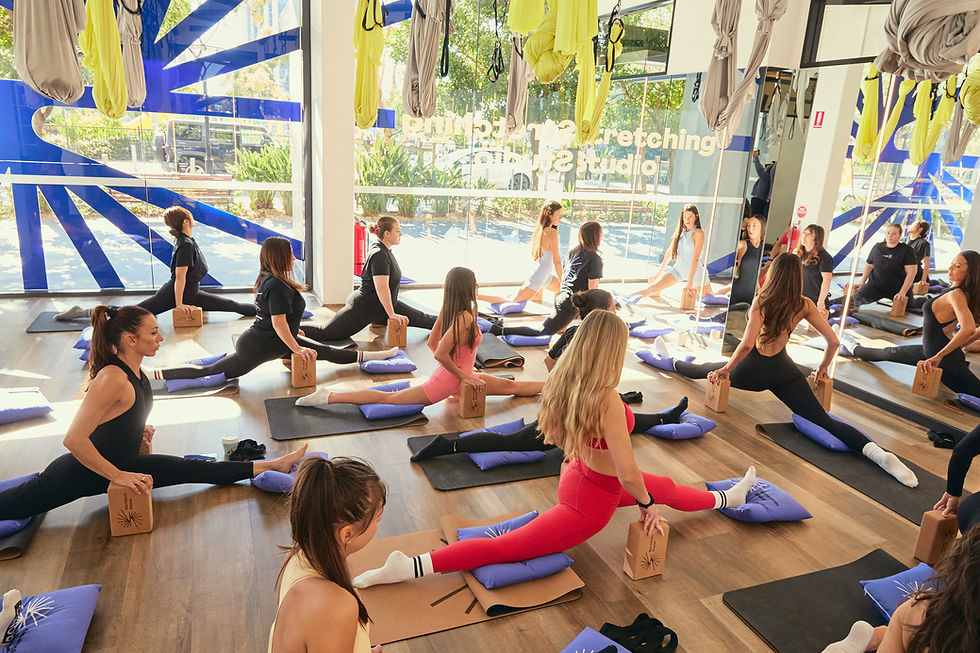Why Full Body Stretching Matters for Fitness
- Senia C

- Aug 18, 2025
- 4 min read
Stretching is often overlooked in fitness routines, yet it plays a crucial role in overall health and performance. Incorporating stretching into your daily regimen can improve flexibility, reduce injury risk, and enhance muscle recovery. This article explores why stretching matters, the benefits of stretching, and practical tips to make it a consistent part of your fitness journey.
The Importance of Flexibility in Fitness
Flexibility is the ability of your joints and muscles to move through their full range of motion. It is a foundational component of physical fitness that supports strength, balance, and coordination. Without adequate flexibility, your body becomes prone to stiffness, muscle imbalances, and injuries.
Regular stretching helps maintain and improve flexibility by lengthening muscles. This increased elasticity allows for smoother, more efficient movements during exercise and daily activities. For example, runners with flexible hamstrings and calves experience less strain and better stride mechanics.
Moreover, flexibility contributes to better posture by counteracting the effects of prolonged sitting or repetitive movements. Stretching tight muscles in the chest and hips can prevent slouching and lower back pain, common complaints among active and sedentary individuals alike.

The Benefits of Stretching for Your Body and Mind
Stretching offers a wide range of benefits that extend beyond just physical improvements. Here are some key advantages:
Injury Prevention: Stretching prepares muscles and joints for activity by increasing blood flow and warming tissues. This reduces the risk of strains, sprains, and tears during workouts or sports.
Enhanced Performance: Flexible muscles can contract more efficiently, improving strength, speed, and agility. Athletes often incorporate stretching to optimise their performance.
Improved Circulation: Stretching stimulates blood flow, which helps deliver oxygen and nutrients to muscles. This supports faster recovery and reduces muscle soreness.
Stress Relief: Stretching activates the parasympathetic nervous system, promoting relaxation and reducing tension. It can be a calming ritual after a busy day or intense exercise.
Better Posture and Balance: Regular stretching corrects muscle imbalances and tightness that contribute to poor posture. This leads to improved balance and reduced risk of falls.
Incorporating a routine that includes full body stretching can maximise these benefits by targeting all major muscle groups and joints.

How to Incorporate Stretching into Your Fitness Routine
To reap the full benefits of stretching, it should be a regular part of your fitness routine. Here are some practical tips:
Book Stretch Classes at Stretch Base
Warm Up First: Stretching cold muscles can cause injury. Begin with 5-10 minutes of light cardio like walking or jogging to increase blood flow.
Stretch After Workouts: Post-exercise stretching helps relax muscles and improve flexibility. Spend 10-15 minutes focusing on major muscle groups.
Use Proper Technique: Avoid bouncing or forcing stretches. Hold each stretch gently for 20-30 seconds and breathe deeply.
Include Both Static and Dynamic Stretches: Static stretches involve holding a position, while dynamic stretches involve controlled movements. Both have unique benefits.
Create a Stretching Schedule: Aim to stretch at least 3-4 times per week. Consistency leads to lasting flexibility gains.
Listen to Your Body: Stretching should never be painful. If you feel sharp pain, ease off or modify the stretch.
Joining a class or following guided routines can provide structure and motivation. For example, full body stretching classes offer expert guidance and a supportive environment.
Stretching for Recovery and Injury Prevention
Recovery is a vital part of any fitness program, and stretching plays a key role in this process. After intense workouts, muscles can become tight and sore. Stretching helps:
Reduce Muscle Stiffness: Lengthening muscles post-exercise prevents them from becoming tight and uncomfortable.
Enhance Blood Flow: Improved circulation speeds up the removal of metabolic waste products like lactic acid.
Maintain Range of Motion: Stretching keeps joints mobile, reducing the risk of stiffness and injury.
Prevent Overuse Injuries: Balanced flexibility reduces strain on muscles and tendons, lowering the chance of repetitive stress injuries.
Incorporate gentle stretching into your cool-down routine to support recovery. Focus on areas that feel tight or fatigued.
Making Stretching a Lifestyle Habit
To truly benefit from stretching, it should become a lifestyle habit rather than a sporadic activity. Here are some strategies to help you stay consistent:
Set Reminders: Use phone alarms or calendar alerts to schedule stretching sessions.
Combine with Other Activities: Stretch while watching TV, after waking up, or before bed.
Track Progress: Note improvements in flexibility or reduced muscle tightness to stay motivated.
Find a Stretching Buddy: Partnering with someone can increase accountability.
Explore Different Styles: Try Aerial stretch classes, Yoga, Pilates, or dedicated stretch classes to keep things interesting.
Remember, even short daily sessions can make a significant difference over time.
Stretching is a simple yet powerful tool that enhances fitness, prevents injury, and promotes overall well-being. By integrating full body stretching into your routine, you invest in your body’s long-term health and performance. Start today and experience the transformative benefits of a flexible, resilient body.





Comments